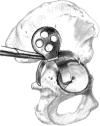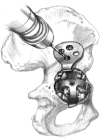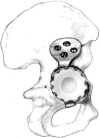The use of fibre-based demineralised bone matrix in major acetabular reconstruction: surgical technique and preliminary results
- PMID: 21057788
- PMCID: PMC3032110
- DOI: 10.1007/s00264-010-1145-y
The use of fibre-based demineralised bone matrix in major acetabular reconstruction: surgical technique and preliminary results
Abstract
Acetabular osteolysis associated with socket loosening is one of the main long-term complications of total hip arthroplasty. In case of major bone loss, where <50% host bone coverage can be obtained with a porous-coated cementless cup, it is generally agreed that a metal ring or cage in association with a cemented component and allograft bone should be used. In order to promote allograft bone consolidation and incorporation, we have associated demineralised bone matrix (DBM, Grafton® A Flex) to the construct ion. Here we describe the technical details of major acetabular reconstruction using the Kerboull acetabular reinforcement device with allograft bone and DBM. This device has a hook that must be placed under the teardrop of the acetabulum and a plate for iliac fixation. The main advantages of this device are help in restoring the normal centre of hip rotation, guiding the reconstruction and partially unloading the graft. The Kerboull acetabular reinforcement device has provided a 92% survival rate free of loosening at 13-year follow-up in a consecutive series of 60 type III and IV deficiencies. Our preliminary results using DBM indicate faster allograft consolidation and remodelling.
Figures




Similar articles
-
[Acetabular revision for aseptic loosening in total hip arthroplasty using cementless cup and impacted morselized allograft].Rev Chir Orthop Reparatrice Appar Mot. 2007 May;93(3):255-63. doi: 10.1016/s0035-1040(07)90247-0. Rev Chir Orthop Reparatrice Appar Mot. 2007. PMID: 17534208 French.
-
Revision Total Hip Arthroplasty Using the Kerboull Acetabular Reinforcement Device and Structural Allograft for Severe Defects of the Acetabulum.J Arthroplasty. 2017 Nov;32(11):3502-3509. doi: 10.1016/j.arth.2017.06.029. Epub 2017 Jun 23. J Arthroplasty. 2017. PMID: 28711340
-
Acetabular bone defects in THA revision: Reconstruction using morsellised virus-inactivated bone allograft and reinforcement ring. Seven-year outcomes in 95 patients.Orthop Traumatol Surg Res. 2017 Jun;103(4):543-548. doi: 10.1016/j.otsr.2017.03.008. Epub 2017 Mar 30. Orthop Traumatol Surg Res. 2017. PMID: 28366746
-
Acetabular reinforcement rings associated with allograft for severe acetabular defects.Int Orthop. 2019 Mar;43(3):561-571. doi: 10.1007/s00264-018-4142-1. Epub 2018 Sep 13. Int Orthop. 2019. PMID: 30218182 Review.
-
Acetabular reconstruction using porous metallic material in complex revision total hip arthroplasty: A systematic review.Orthop Traumatol Surg Res. 2019 Feb;105(1S):S53-S61. doi: 10.1016/j.otsr.2018.04.030. Epub 2018 Aug 20. Orthop Traumatol Surg Res. 2019. PMID: 30138711
Cited by
-
Retention of a well-fixed acetabular component in the setting of acetabular osteolysis.Int Orthop. 2012 May;36(5):949-54. doi: 10.1007/s00264-011-1372-x. Epub 2012 Feb 21. Int Orthop. 2012. PMID: 22350140 Free PMC article.
-
The available evidence on demineralised bone matrix in trauma and orthopaedic surgery: A systematic review.Bone Joint Res. 2017 Jul;6(7):423-432. doi: 10.1302/2046-3758.67.BJR-2017-0027.R1. Bone Joint Res. 2017. PMID: 28733366 Free PMC article.
-
Bone graft incorporation after revision hip arthroplasty in patients with rheumatoid arthritis: seventy eight revisions using bone allografts with or without metal reinforcements.Int Orthop. 2013 Apr;37(4):595-8. doi: 10.1007/s00264-013-1794-8. Epub 2013 Feb 8. Int Orthop. 2013. PMID: 23392345 Free PMC article.
-
Total Hip Arthroplasty, state of the art for the 21st century.Int Orthop. 2011 Feb;35(2):149-50. doi: 10.1007/s00264-011-1207-9. Epub 2011 Jan 18. Int Orthop. 2011. PMID: 21243356 Free PMC article. No abstract available.
-
Bone grafts, bone graft extenders, substitutes and enhancers for acetabular reconstruction in revision total hip arthroplasty.EFORT Open Rev. 2017 Mar 13;1(12):431-439. doi: 10.1302/2058-5241.160025. eCollection 2016 Dec. EFORT Open Rev. 2017. PMID: 28461922 Free PMC article. Review.
References
-
- D’Antonio JA, Capello WN, Borden LS, Bargar WL, Bierbaum BF, Boettcher WG, Steinberg ME, Stulberg SD, Wedge JH. Classification and management of acetabular abnormalities in total hip arthroplasty. Clin Orthop Relat Res. 1989;243:126–137. - PubMed
MeSH terms
LinkOut - more resources
Full Text Sources
Medical

